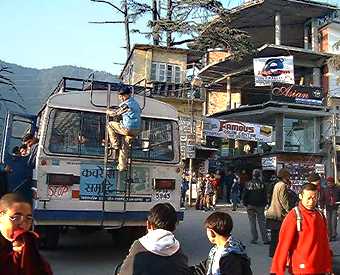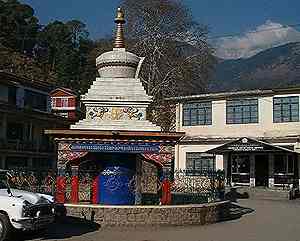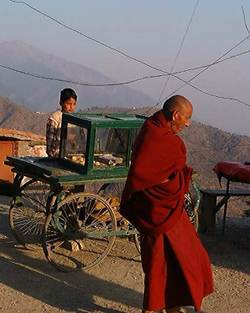|
Following
Gandhi's Path 2
Settling
Conflicts in Dharamsala
By Jan
Oberg,
TFF director
The bus leaves Delhi at around 5 o'clock P.M. (maybe).
There are two kinds of passengers: Tibetan monks and
occidental backpackers. The road north from Delhi appears
to be full of completely chaotic traffic. The trip is
said to provide wonderful sights of the mighty Himalayan
Mountains. However, when we arrive it is pitch-black and
we had spent a long time dozing leaning on one another's
shoulders. When I sometimes awake, I can't see much more
than rock-faces running away either to the right or the
left in erratic beams of light. One thing is sure, Indian
bus drivers really do know how to manage on serpentine
roads…
After thirteen hours of bus riding, I arrive at
Dharamsala, which is a religious, political and cultural
centre for a couple of hundred thousand exiled Tibetans
and lies at a height of 1300 metres in the Himalayas. In
the chilly darkness I wrap myself in a special
khadi-blanket I bought in Delhi's Gandhi Museum with
thoughts of the cold in the mountains. I start walking on
a narrow mountain way with no street-lights at all but
with locked-up hovels alongside. Suddenly an unobserved
shawl-clad figure emerges from the obscurity and asks
where I'm going to. "To Kashmere House", I reply and five
minutes later a mini cab is driving me to the place. This
is where I and my friends from Danish Centre for Conflict
Resolution shall teach young, exiled Tibetans how to
analyse and handle situations of conflict and how the
big, outside world - which they have good reasons to feel
deserted by - actually works.

Photo Jan Oberg, © TFF
2001
Bus Square in
Dharamsala
Dharamsala is divided in topographical levels.
Dharamsala proper, with the hospital, the municipal
administration and the Tibetan cultural centre (Nobulinka
Institute) is situated in the beautiful and impressive
Kanga valley, above which there are always huge dark
birds of prey circulating. That is some 10 kilometres
from Lower Dharamsala, through rice fields and wonderful
nature. Lower Dharmsala, where I had arrived, consists
mainly of dwelling houses, bazaar-crowded streets and two
Internet cafés.
I knock on the windows and doors to Kashmere House, a
fairy-tale-like building of colonial origin, and finally
a night watchman appears. I get a couple hours of normal
sleep. Then it is time to explore a bit. On the narrow
bumpy road it is about 5 kilometres uphill to Gangchen
Kyishong, the government block housing the Tibetan
Parliament, various departments and the security office.
However, I choose to walk and climb for about half an
hour along one of the many slippery shortcuts, sometimes
wandering all alone, sometimes encountering small groups
of cottages and poultry-farms, and sometimes meeting
shepherds, old women, cows and goats. It takes another
hour of walking to reach a height of 1768 metres and to
find Upper Dharamsala, or McLeod Ganj - the local
tourists' Mecca with restaurants, temples, shops,
handicrafts, museums, post offices, book-sellers and His
Holiness the Dalai Lama's amazingly plain and
architecturally dull temple, Tsuglagkang.

Photo Jan Oberg, © TFF
2001
Government Square
with the parliament in the background
David McLeod was a "lieutenant governor" in the 1850s
when the town was a British barracks. The small colonial
shop looks as if McLeod will step through the door at any
minute. In those days Dharamsala was inhabited by the
half nomadic Gaddi people who were neither "Indians" nor
Tibetans.
I am very proud of having been invited to assist these
eager-to -learn and humorous young Tibetans. But why do
they want to establish their first-ever Tibetan centre
for handling conflicts? The answer might be found in the
topic of a lecture I have been asked to give at the
exile-government's Ministry of Foreign Affairs: how to
settle conflicts when the counterpart is mightier and
shows no interest in carrying on a dialogue.
Because this is what is troubling the Tibetans in a
nutshell: 5-6 million people were occupied - as they see
it - by a superior force. 6-8 million Chinese people have
since moved to Tibet, where the Tibetans are themselves
now a minority in their own historically independent
country. Furthermore, the Chinese have based the larger
part of their nuclear weapon program in Tibet, thus
polluting the globally unique fauna and flora - depleting
them or so they outright disappear.
Having said that much I think I should also emphasise
that I haven't been either in Tibet or visited Beijing in
order to study and comprehend the entire matter of Tibet.
I actually would love to do that. Books on Tibet and the
Internet have taught me that sound arguments can be found
on all sides.
Another reason why Tibetans in India wish to learn how
to settle conflicts is that there is a conflict between
the Tibetans born in India, who look upon themselves as
better educated and more "civilised", and those born on
the other side of the mountains in Tibet, who the former
consider to be more "primitive". Conflicts even exist
between the group of young people who appreciate the
Dalai Lama and non-violence, and the more revolutionary
group that believes that - at least after him - there
must be an armed revolution since non-violence has not
achieved anything. Moreover, there are also conflicts
between Tibetans and Indians within the local
societies.
Instead of traditional instructing or lecturing, we
had a dialogue that was to the benefit of both parties.
It's hard to imagine anything more meaningful than
cooperating with these 20 to 30-year-old people. They and
their families have gone through a lot of hardship, are
all refugees, deeply religious and yet they have kept
their tolerance, their curiosity and their dignity
intact. In their company I felt very happy about being a
peace researcher and activist. We parted as the best of
friends.
It strikes me that, as things are now, they don't have
much of a chance to see a free Tibet during their
lifetimes. If there will be an independent Tibet, it must
be shared between the Tibetans and all the Chinese
residents, who themselves are victims of a big power
game. Not an ethnically cleansed Tibet. I never saw any
hate in the eyes of these youths, nor heard them say
anything malevolent.

Photo Jan Oberg, © TFF
2001
Monk in Dharamsala
Tibetans are generally very positive and deeply
religious. They believe both in respect and, just like
the Dalai Lama, in laughter! Buddhism is all about how to
overcome suffering, attain happiness, tolerance and
empathy, as well as about striving for "mindfulness" and
"loving kindness" - to live wholly attentive and with the
friendliness of love. That's not a bad start for a
conflict settlement and reconciliation philosophy!
If I succeeded in giving them anything at all in
exchange for what they taught me about the Tibetan
conflict, then it was widening their views on Gandhi and
non-violence as an active, not passive, philosophy and
policy. There are many similarities between the Lama and
the Mahatma, but the latter was even a political and
strategic fighter.
Translated by Alice
Moncada
Translation edited by Sara E. Ellis
Other
articles about India, "Following Gandhi's Path" and
picture galleries
©
TFF 2002

Tell a friend about this article
Send to:
From:
Message and your name
|